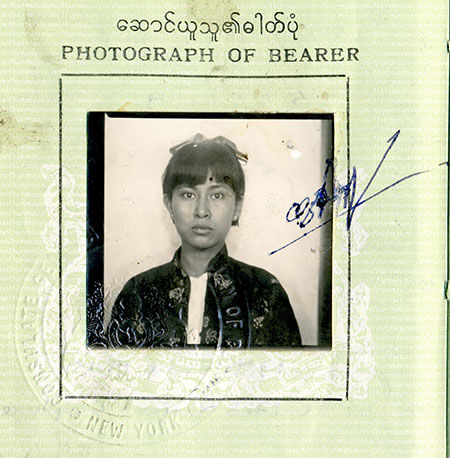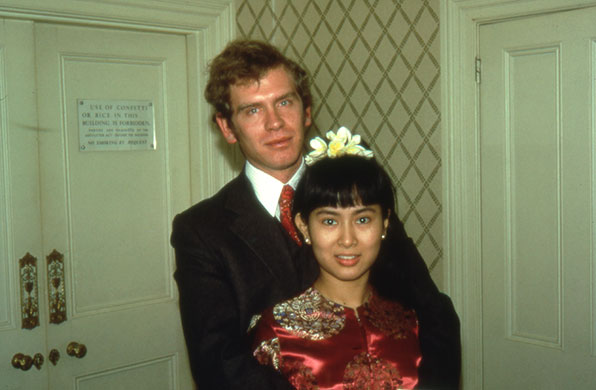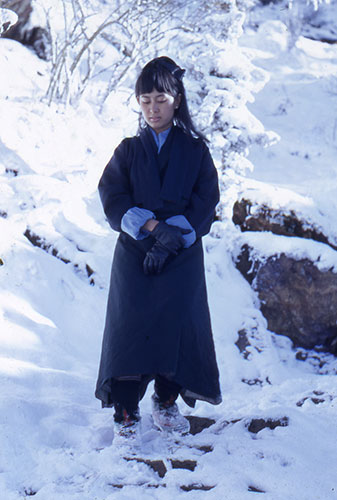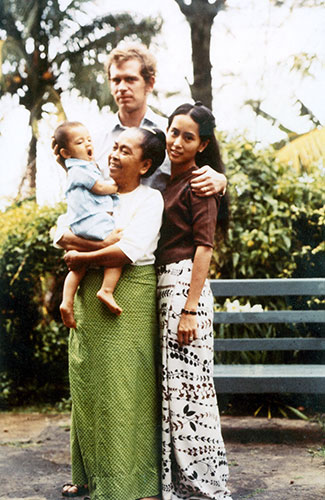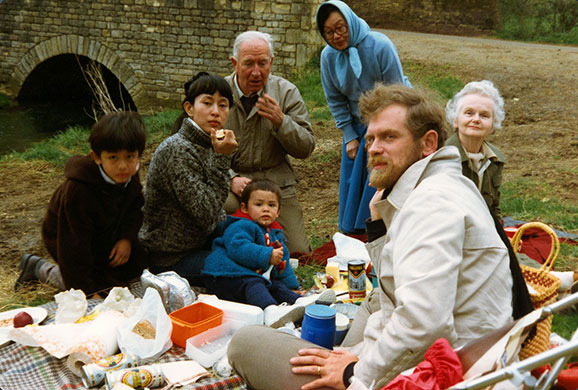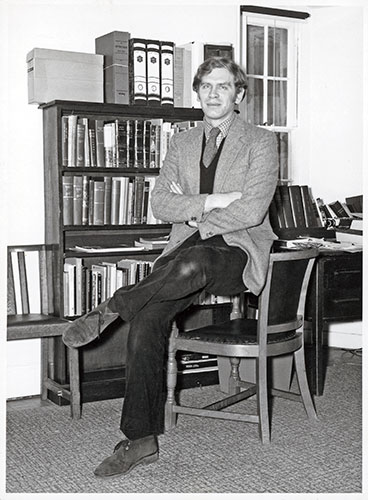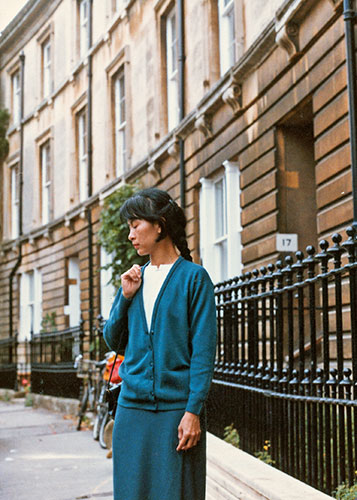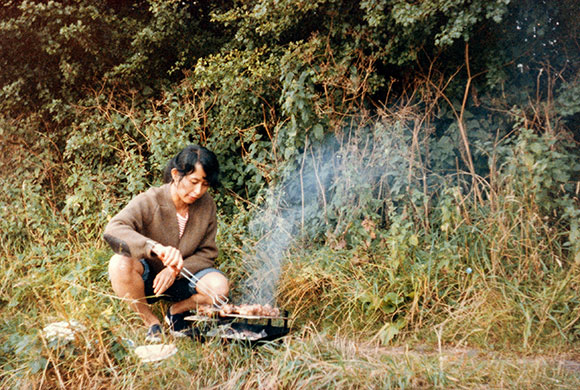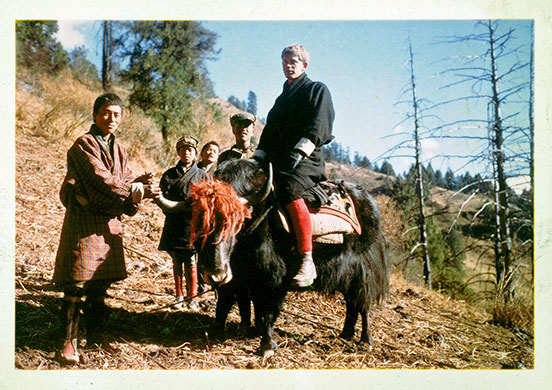But hope quickly turned to fear as residents noticed that the Khmer Rouge troops weren't celebrating with them. Embittered and toughened after years of brutal civil war and American bombing, the Khmer Rouge marched the boulevards of Phnom Penh with icy stares carved into their faces. The troops soon began to order people to abandon their homes and leave Phnom Penh. By mid-afternoon hundreds of thousands of people were on the move. "The Americans are going to bomb the city!" was the answer given to residents if they asked why they had to leave Phnom Penh. No exceptions were made - all residents, young and old, had to evacuate as quickly as possible.
As the Khmer Rouge well knew, there were no American plans to attack the city. The deception was a ploy to get people into the countryside, away from the urban confines of the city. The Khmer Rouge believed that cities were living and breathing tools of capitalism in their own right - KR cadres referred to Phnom Penh as "the great prostitute of the Mekong." In order to create the ideal communist society, all people would have to live and work in the countryside as peasants. Peasants, in fact, were the Khmer Rouge communist ideal, not unlike the blonde-haired, blue-eyed Aryan of Nazi Germany. Peasants were seen as simple, uneducated, hard-working and not prone to exploiting others. Their way of life had not changed for centuries, yet they always managed to survive. It was this perception that caused the Khmer Rouge to view peasants - old people, to use their political jargon - as the ideal communists for the new Cambodian state.
The city dwellers of Phnom Penh and other Cambodian cities, on the other hand, were seen as new people (or "April 17 people"). New people were the root of all capitalist evil in the eyes of the Khmer Rouge. It didn't matter if you were a teacher, a tailor, a civil servant or a monk: new people were the embodiment of capitalism and the enemy of communism, their personal political ideologies irrelevant. The Khmer Rouge felt that new people had made an active choice to live in the cities and thus declared their allegiance to capitalism. All city dwellers became enemies of the new communist state, a status that would cost hundreds of thousands of them their lives.
Evacuation of the cities was the first of many radical steps taken by the Khmer Rouge. As new people were forced out of the urban centers they soon learned of the new rules that were being imposed by Angka ("The Organization"), the secretive team of Khmer Rouge leaders who dictated the lives of every Cambodian citizen. Among these new rules, religion, money and private ownership were all banned; communications with the outside world elimated; family relationships dismantled. All previous rights and responsibilities were thrown out the window. As was often said by the Khmer Rouge, 2000 years of Cambodian history had now come to an end; April 17 was the beginning of Year Zero for the new Cambodia: Democratic Kampuchea (DK).

The Rise and Fall of the Khmer Rouge

In 1965, Prince Norodom Sihanouk, Cambodia's head of state, asserted the nation's opposition to the U.S.-backed government in South Vietnam by allowing North Vietnamese guerrillas to set up bases within Cambodia's borders. The North Vietnamese had an alliance with a Cambodian Marxist insurgency group, the Khmer Rouge, whose top brass Sihanouk is pictured here with in 1973.

A Cambodian soldier holds a .45 to the head of a Khmer Rouge suspect in 1973. When Sihanouk was forced out of power in a coup, the new Prime Minister, General Lon Nol, sent the army to fight t he North Vietnamese and the Khmer Rouge in Cambodia. Fighting two enemies proved to be too much for Cambodia's army. As Civil War raged from 1970 to 1975, the army gradually lost territory as Khmer Rouge increased its control in the countryside.

Survivors sift through rubble after the Khmer Rouge bombed Phnom Penh, the capital city, on January 1, 1975. Four months later, the party took the city, on April 17, 1975, and began their mission of returning Cambodia to an agrarian society, emptying the cities and forcing their countrymen into agricultural labor.

Day One, Year Zero
Khmer Rouge fighters celebrate as they enter Phnom Penh on April 17, 1975. Prince Sihanouk, the party's early ally, resigned in 1976, paving the way for the now notorious Khmer Rouge founder and leader, Pol Pot, to become prime minister. The country was renamed Kampuchea, and it was the start Year Zero — the beginning of a new history for Cambodia written by Pol Pot.

Left Behind
Days before the occupation of the capital, thousands of Cambodians gather behind a school perimeter fence near the American embassy to watch the final evacuation of U.S. and foreign nationals.
A prisoner gets her mug shot taken. At prisons like Phnom Penh's infamous Tuol Sleng, prisoners were painstakingly documented before being sent to their deaths in mass graves later to be come known as the "killing fields." Hundreds of thousands of intellectuals were tortured and executed under the Khmer Rouge; others starved or died from disease or exhaustion. In total, an estimated 1.7 million Cambodians died between 1975 and 1979.

Pol Pot's Utopia
An undated photograph shows forced laborers digging canals in Kampong Cham province, part of the massive agrarian infrastructure the Khmer Rouge planned for the country.

A New Occupier
Fed up with cross-border raids by Khmer Rouge, Vietnam invaded Cambodia on Dec. 25, 1978. By Jan. 7, shown here, Vietnamese troops had occupied Phnom Penh. The Vietnamese occupation of Cambodia lasted for 10 years.
Fed up with cross-border raids by Khmer Rouge, Vietnam invaded Cambodia on Dec. 25, 1978. By Jan. 7, shown here, Vietnamese troops had occupied Phnom Penh. The Vietnamese occupation of Cambodia lasted for 10 years.

Fearless Leader
The Vietnamese overthrew Pol Pot, too, driving the leader to the Thai border where he continued to head the Khmer Rouge in the jungles.
The Vietnamese overthrew Pol Pot, too, driving the leader to the Thai border where he continued to head the Khmer Rouge in the jungles.

Purging the Western Curse The Khmer Rouge sought to rid Cambodia of all Western influences that distracted its people from their agrarian calling. Cars, abandoned and forbidden, were stacked up alongside the road.
A Bloody Landscape
An exhumed mass grave, pictured in 1981, in the Cambodian countryside reveals the skeletons of those executed and buried together under Pol Pot's regime.
In Cambodia, Pol Pot's Regime on Trial at Last


An exhumed mass grave, pictured in 1981, in the Cambodian countryside reveals the skeletons of those executed and buried together under Pol Pot's regime.
In Cambodia, Pol Pot's Regime on Trial at Last

A Bloody Landscape
An exhumed mass grave, pictured in 1981, in the Cambodian countryside reveals the skeletons of those executed and buried together under Pol Pot's regime.
An exhumed mass grave, pictured in 1981, in the Cambodian countryside reveals the skeletons of those executed and buried together under Pol Pot's regime.

The Resistance Khmer Rouge guerrillas in the jungle of western Cambodia as they attempt to halt advancing Vietnamese forces on Feb. 15, 1981.

Death Sentence
A prisoner gets her mug shot taken. At prisons like Phnom Penh's infamous Tuol Sleng, prisoners were painstakingly documented before being sent to their deaths in mass graves later to be come known as the "killing fields." Hundreds of thousands of intellectuals were tortured and executed under the Khmer Rouge; others starved or died from disease or exhaustion. In total, an estimated 1.7 million Cambodians died between 1975 and 1979.











 但弗兰岑就是登上了《时代》周刊的封面,而且这份老牌杂志以自己的影响力把作家的声名传播得更广更远。在中国,《纠正》的中译本3年前就由译林出版社出 版,但它在中国依旧鲜有人知。若不是因为《时代》周刊的封面故事,它或许就像很多杰出且无人问津的伟大作品一样,被人束之高阁后,作为废纸被回收,与各种 低廉、花哨的印刷品一起,融成纸浆做成新纸张。
但弗兰岑就是登上了《时代》周刊的封面,而且这份老牌杂志以自己的影响力把作家的声名传播得更广更远。在中国,《纠正》的中译本3年前就由译林出版社出 版,但它在中国依旧鲜有人知。若不是因为《时代》周刊的封面故事,它或许就像很多杰出且无人问津的伟大作品一样,被人束之高阁后,作为废纸被回收,与各种 低廉、花哨的印刷品一起,融成纸浆做成新纸张。 2010年8月末,弗兰岑的第4本大作《自由》在美国出版。像《纠正》一样,《自由》讲述的也是一个美国家庭的故事。之前,美国总统奥巴马在麻省科德角玛 莎葡萄园度假时,不小心在当地著名的“葡萄串”书店获得了一本试读本,谁知引发了一连串麻烦……这件事被热炒后,弗兰岑随即被请上《时代》周刊的封面,成 为“伟大的美国作家”。
2010年8月末,弗兰岑的第4本大作《自由》在美国出版。像《纠正》一样,《自由》讲述的也是一个美国家庭的故事。之前,美国总统奥巴马在麻省科德角玛 莎葡萄园度假时,不小心在当地著名的“葡萄串”书店获得了一本试读本,谁知引发了一连串麻烦……这件事被热炒后,弗兰岑随即被请上《时代》周刊的封面,成 为“伟大的美国作家”。




